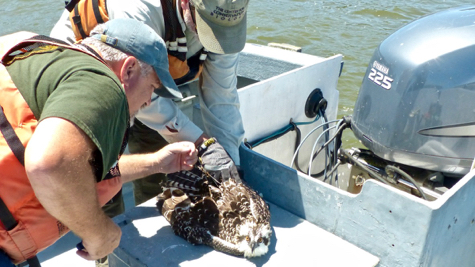Plastic pollution hits home for OspreyCam followers
Fledgling maimed by discarded monofilament fishing line
Followers of the live OspreyCam video stream offered by William & Mary's Virginia Institute of Marine Science were subjected to a gut-wrenching display last week as one of this year’s two chicks became entangled in fishing line brought to the nest by a parent.
Despite efforts by staff from VIMS, the Center for Conservation Biology at William & Mary, and the Wildlife Center of Virginia, the line and consequent immobility caused so much damage to the wing of the fledgling chick that the young bird — estimated at 7-8 weeks of age — had to be euthanized.
Ernesto Dominguez, the Wildlife Center’s Hospital director, says, “The trauma to the left wing was too severe to correct, either surgically or medically—thus ruling out the possibility of recovery and release.”
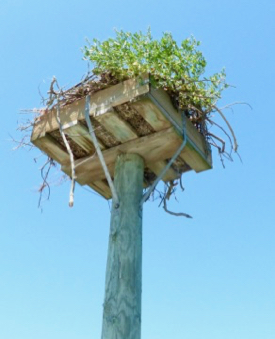 Bryan Watts, director of the Center for Conservation Biology, headed the effort to reach and disentangle the chick — a difficult endeavor given the nest’s location on a tall pole rising from the shallow, wave-tossed waters in front of the VIMS campus in Gloucester Point. Aiding in the rescue effort were VIMS Marine Safety Officer Jim Goins and News & Media Director David Malmquist, who helped establish the VIMS OspreyCam in 2011.
Bryan Watts, director of the Center for Conservation Biology, headed the effort to reach and disentangle the chick — a difficult endeavor given the nest’s location on a tall pole rising from the shallow, wave-tossed waters in front of the VIMS campus in Gloucester Point. Aiding in the rescue effort were VIMS Marine Safety Officer Jim Goins and News & Media Director David Malmquist, who helped establish the VIMS OspreyCam in 2011.
A chronic issue
Watts — who also founded OspreyWatch, an online community focused on observing breeding osprey in more than 6,000 nests worldwide — notes that trash in osprey nests is a chronic problem, one that stems from the birds’ instinctual habit of retrieving eelgrass blades and other naturally buoyant materials to line the nesting surface.
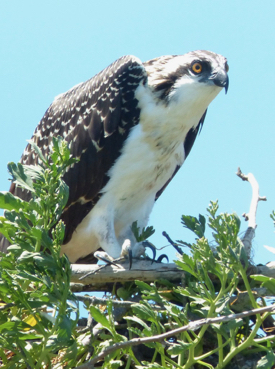 Indeed, during the last few years, followers of the VIMS OspreyCam have seen the breeding adults return to the nesting platform with plastic bags, cup lids, flip-flops, a swim diaper and other unidentifiable plastic items. Monofilament fishing line — whose chemical formulations include polyethylene terephthalate and polyvinylidene fluoride — is yet another form of this plastic trash.
Indeed, during the last few years, followers of the VIMS OspreyCam have seen the breeding adults return to the nesting platform with plastic bags, cup lids, flip-flops, a swim diaper and other unidentifiable plastic items. Monofilament fishing line — whose chemical formulations include polyethylene terephthalate and polyvinylidene fluoride — is yet another form of this plastic trash.
“It’s in almost all the nests, some type of trash,” says Watts. “Most is not really dangerous to the chicks, they just use it for lining, pieces of clothing and things like that … But when they pick up monofilament lines, those are much more hazardous, because the chicks can become entangled.”
As anyone who has handled monofilament line knows, the tensile strength and durability that has made this plastic material so popular with anglers also makes it extremely difficult to disentangle or break.
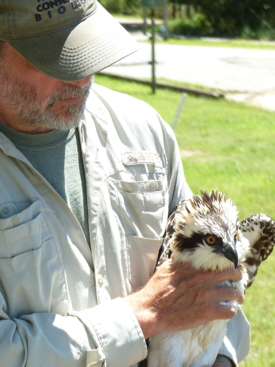 The timing of entanglement for the OspreyCam chick — a female — was particularly unfortunate, as it occurred during the critical period when the developing nestlings begin to exercise and strengthen the wing and breast muscles needed for fledging and flight.
The timing of entanglement for the OspreyCam chick — a female — was particularly unfortunate, as it occurred during the critical period when the developing nestlings begin to exercise and strengthen the wing and breast muscles needed for fledging and flight.
“It (the entanglement) was particularly bad at a time like this when the bird is developing muscle and control,” says Watts.
Recognition of the potential environmental impacts of discarded monofilament line has led many conservation organizations — including the U.S. Fish and Wildlife Service and the Clean Marina program at VIMS — to place specially designed monofilament recycling receptacles in and near areas frequented by anglers. There have also been efforts to develop biodegradable alternatives, using materials similar to those being tested for use in biodegradable crab-pot panels at VIMS.
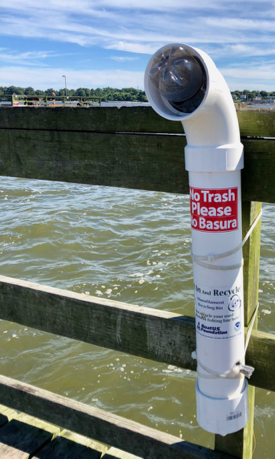 The angling site nearest the VIMS OspreyCam — the Gloucester Point Fishing Pier — features three such containers. Unfortunately, despite clear instructions and warnings, a recent visit to one of these containers showed it clogged by a firmly lodged plastic bottle.
The angling site nearest the VIMS OspreyCam — the Gloucester Point Fishing Pier — features three such containers. Unfortunately, despite clear instructions and warnings, a recent visit to one of these containers showed it clogged by a firmly lodged plastic bottle.
Whether the particular length of monofilament line that the adult osprey returned to the OspreyCam nest was purposefully discarded or the result of a broken snag, the results were tragically the same.
Malmquist says, “It breaks my heart that carelessness or thoughtlessness on the part of an angler may have led to the death of this magnificent creature. We can all do better when it comes to cleaning up after ourselves when in the outdoors. ”
The problem in miniature
VIMS Professor Rob Hale, whose current research focuses on pollution by microplastics in the aquatic environment, says the osprey’s predicament serves as an unfortunate and visible reminder of what may well also be occurring on a miniature scale.
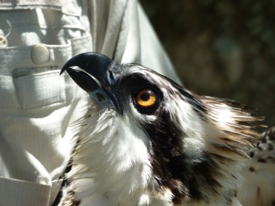 “When plastics are discarded it’s just the beginning of a chain of events,” says Hale. “You have this impact on larger organisms — the so-called charismatic megafauna — but the same sort of predicaments occur with smaller fragments of plastics and smaller organisms. A big issue with microplastics now is filaments— from things like outdoor wear that is made out of synthetic fibers — it’s basically a miniature version of monofilament fishing line.”
“When plastics are discarded it’s just the beginning of a chain of events,” says Hale. “You have this impact on larger organisms — the so-called charismatic megafauna — but the same sort of predicaments occur with smaller fragments of plastics and smaller organisms. A big issue with microplastics now is filaments— from things like outdoor wear that is made out of synthetic fibers — it’s basically a miniature version of monofilament fishing line.”
“We see these impacts with larger organisms like the osprey and it’s obvious,” he adds, “but this also happens on a micro-scale — with impacts on zooplankton and the other smaller organisms we don’t see.”
Meredith Evans, a doctoral student studying plastics in Hale’s lab, is currently in Alaska, studying the environmental impacts of derelict fishing gear.
Says Hale, “Our main interest there relates to fishing nets and other fishing gear, which hasn’t been examined much in terms of its breakdown. We see the ghost fishing, but what really happens to these nets as they degrade and release materials? We produce billions of these small fibers, and superimpose them on organisms at a small scale—it may well have similar impacts.”
 Skip to main content
Skip to main content

